小学英语语法总复习(整理版)
人教版小学六年级总复习英语语法知识最全整理+语法专项训练题

小学英语语法知识最全整理+语法专项训练题一、小学英语语法知识最全整理第一章名词(Noun)名词的概念在生活中,我们会接触到各种各样的人和事物,用来表示这些人或事物名称的词就是名词。
一、名词的数名词的数指名词的单数和复数形式。
可数名词表示“一个”时用单数,“两个以上”时用复数;不可数名词表示量时,通常用“数词+单位+of+物质名词”的形式,如 a piece ofbread (一片面包),变为复数时,只须将单位名词变为复数,如:two pieces of bread(两片面包)。
*名词复数的构成法则1. 一般情况下在词尾加 s. 词尾读音shop --- shops (商店) 在清辅音后读 [ s ]bag --- bags (书包) 在浊辅音后读[ z ]window --- windows (窗户) 在元音后读 [ z ]2. 以 s, x, sh, ch结尾的单词在词尾加es。
class --- classes (班级) 词尾读音[ iz ]box --- boxes (盒子)match --- matches (比赛)brush --- brushes (刷子)3. 以“辅音字母 +y”结尾的词,变y为 i 加es.story --- stories (故事) 词尾读音[ iz ]4. 以“元音字母 +y”结尾的词,在词尾直接加skey --- keys 词尾读音[ z ]monkey --- monkeys5.以“o”结尾的名词,复数一般在词尾加“s”,但个别加“es”tomato --- tomatoes (西红柿) 词尾读音[ z ]potato --- potatoes (土豆)zoo --- zoos (动物园)photo --- photos (照片)*(以“o”结尾,复数加“es”)口诀:黑人(Negro)英雄(hero),左手拿着西红柿(tomato),右手拿着破土豆(potato),头顶一个大芒果(mango)。
(完整版)小学1-6年级英语语法汇总表(最新修正本)

小学1-6年级英语语法汇总表(最新修正本)大眼小状17-10-1123:29小学1-6年级英语语法汇总表一、名词复数规则1.一般情况下,直接加-s,如:book-books, bag-bags, cat-cats, bed-beds2.以s. x. sh. ch结尾,加-es,如:bus-buses, box-boxes, brush-brushes, watch-watches3.以“辅音字母y”结尾,变y为i, 再加-es,如:family-families, strawberry-strawberries4.以“f或fe”结尾,变f或fe为v, 再加-es,如:knife-knives Leaf——leaves5.不规则名词复数:man-men, woman-women, policeman-policemen, policewoman-policewomen,child-children foot-feet, tooth-teeth fish-fish, people-people, Chinese-Chinese, Japanese-Japanese二、一般现在时一般现在时基本用法介绍【No. 1】一般现在时的功能1.表示事物或人物的特征、状态。
如:The sky is blue.天空是蓝色的。
2.表示经常性或习惯性的动作。
如:I get up at six every day.我天天六点起床。
3.表示客观现实。
如:The earth goes around the sun.地球绕着太阳转。
一般现在时的构成1. be动词:主语be(am,is,are) 其它。
如:I am a boy.我是一个男孩。
2.行为动词:主语行为动词( 其它)。
如:We study English.我们学习英语。
当主语为第三人称单数(he, she,it)时,要在动词后加"-s"或"-es"。
小学英语语法总复习(整理版)ppt课件【完整版】

2021年-2022年最新
2021年-2022年
034729
2021年-2022年最新
2021年-2022年
034730
2021年-2022年最新
2021年-2022年
034731
2021年-2022年最新
2021年-2022年
034732
2021年-2022年最新
2021年-2022年
034733
2021年-2022年最新
2021年-2022年
034724
2021年-2022年最新
2021年-2022年
034725
2021年-2022年最新
2021年-2022年
034726
2021年-2022年最新
2021年-2022年
034727
2021年-2022年最新
2021年-2022年
034728
2021年-2022年最新
2021年-2022年
034749
2021年-2022年最新
2021年-2022年
034750
2021年-2022年最新
2021年-2022年
034751
2021年-2022年最新
2021年-2022年
034752
2021年-2022年最新
2021年-2022年
034753
2021年-2022年最新
2021年-2022年
034744
2021年-2022年最新
2021年-2022年
034745
2021年-2022年最新
2021年-2022年
034746
2021年-2022年最新
2021年-2022年
(完整版)小学英语语法大全经典全面
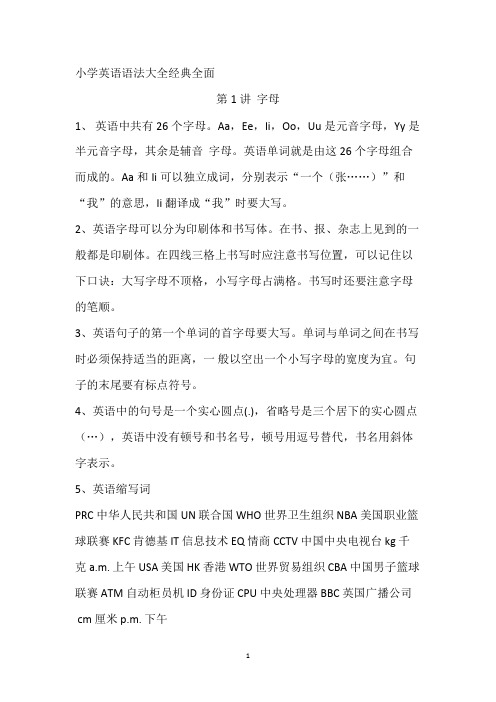
小学英语语法大全经典全面第1讲字母1、英语中共有26个字母。
Aa,Ee,Ii,Oo,Uu是元音字母,Yy是半元音字母,其余是辅音字母。
英语单词就是由这26个字母组合而成的。
Aa和Ii可以独立成词,分别表示“一个(张……)”和“我”的意思,Ii翻译成“我”时要大写。
2、英语字母可以分为印刷体和书写体。
在书、报、杂志上见到的一般都是印刷体。
在四线三格上书写时应注意书写位置,可以记住以下口诀:大写字母不顶格,小写字母占满格。
书写时还要注意字母的笔顺。
3、英语句子的第一个单词的首字母要大写。
单词与单词之间在书写时必须保持适当的距离,一般以空出一个小写字母的宽度为宜。
句子的末尾要有标点符号。
4、英语中的句号是一个实心圆点(.),省略号是三个居下的实心圆点(…),英语中没有顿号和书名号,顿号用逗号替代,书名用斜体字表示。
5、英语缩写词PRC中华人民共和国 UN 联合国 WHO 世界卫生组织 NBA美国职业篮球联赛 KFC 肯德基 IT 信息技术 EQ 情商 CCTV 中国中央电视台 kg 千克 a.m. 上午 USA 美国 HK 香港 WTO 世界贸易组织 CBA 中国男子篮球联赛 ATM 自动柜员机 ID 身份证 CPU 中央处理器 BBC 英国广播公司 cm 厘米 p.m. 下午6、 26个英语字母按照相同的元音因素进行归类:/ eɪ / Aa Hh Jj Kk/ i: / Ee Bb Cc Dd Gg Pp Tt Vv (Zz) / aɪ / Ii Yy /ǝʊ / Oo/ju:/ Uu Qq Ww/ e / Ff Ll Mm Nn Ss Xx Zz /ɑ: /Rr第2讲语音1、音素:语音的最小单位。
英语中共有48个音素,其中元音音素20个,辅音音素28个。
元音单元音 /i:/,/ɪ/,/ɜ:/,/ə/,/ɑ:/,/ /,/ɔ:/,/ɒ/,/u:/,/ʊ/,/e/,/æ/双元音 /eɪ /,/aɪ/,/ɔɪ/,/əʊ/,/aʊ/,/ɪǝ/,/eə/,/ʊə/辅音清辅音 /p/,/t/,/k/,/t /,/tr/,/ts/,/f/,/θ/,/s/,/∫/,/h/浊辅音/b/,/d/,/g/,/dʒ/,/dr/,/dz/,/V/,/ð/,/z/,/ʒ/,/r/,/m/,/n/,/ŋ/,/l/,/w/,/j/2、元音:发音时气流不受阻碍。
小学英语语法大全(完整版)(可打印)
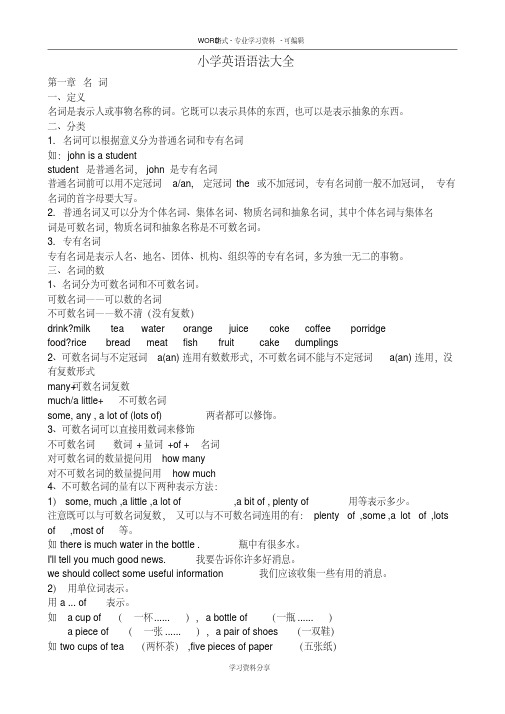
小学英语语法大全第一章名词一、定义名词是表示人或事物名称的词。
它既可以表示具体的东西,也可以是表示抽象的东西。
二、分类1. 名词可以根据意义分为普通名词和专有名词如:john is a studentstudent是普通名词,john是专有名词普通名词前可以用不定冠词a/an, 定冠词the 或不加冠词,专有名词前一般不加冠词,专有名词的首字母要大写。
2. 普通名词又可以分为个体名词、集体名词、物质名词和抽象名词,其中个体名词与集体名词是可数名词,物质名词和抽象名称是不可数名词。
3. 专有名词专有名词是表示人名、地名、团体、机构、组织等的专有名词,多为独一无二的事物。
三、名词的数1、名词分为可数名词和不可数名词。
可数名词——可以数的名词不可数名词——数不清(没有复数)drink?milk tea water orange juice coke coffee porridgefood?rice bread meat fish fruit cake dumplings2、可数名词与不定冠词a(an)连用有数数形式,不可数名词不能与不定冠词a(an)连用,没有复数形式many+可数名词复数much/a little+不可数名词some, any , a lot of (lots of) 两者都可以修饰。
3、可数名词可以直接用数词来修饰不可数名词数词 +量词 +of + 名词对可数名词的数量提问用how many对不可数名词的数量提问用 how much4、不可数名词的量有以下两种表示方法:1) some, much ,a little ,a lot of ,a bit of , plenty of 用等表示多少。
注意既可以与可数名词复数,又可以与不可数名词连用的有:plenty of ,some ,a lot of ,lots of ,most of 等。
如there is much water in the bottle .瓶中有很多水。
(完整版)小学最全英语语法汇总
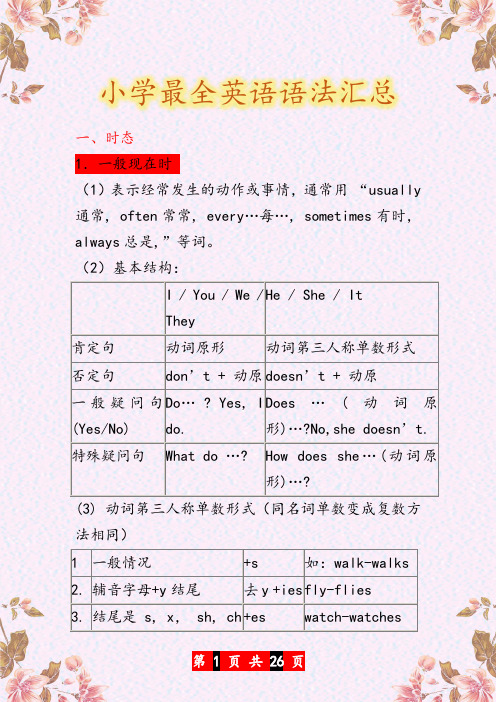
小学最全英语语法汇总一、时态1.一般现在时(1)表示经常发生的动作或事情,通常用“usually 通常, often常常, every…每…, sometimes有时,always总是,”等词。
(2)基本结构:I / You / We /TheyHe / She / It肯定句动词原形动词第三人称单数形式否定句don’t + 动原doesn’t + 动原一般疑问句(Yes/No) Do… ? Yes, Ido.Does…(动词原形)…?No,she doesn’t.特殊疑问句What do …? How does she…(动词原形)…?(3) 动词第三人称单数形式(同名词单数变成复数方法相同)1 一般情况+s 如:walk-walks2. 辅音字母+y结尾去y +ies f ly-flies3. 结尾是 s, x, sh, ch +es watch-watches4.特殊的do-does ,have-has, go-goes2.现在进行时,(1)表示正在发生的动作,通常用“now现在, look 看,linsen听”.(2)基本形式: be + 动词ingeg: I am(not) doing my homework.You/We/They are(not) reading.He/She/It is(not) eating.What are you doing?Is he reading?(3)动词的现在分词形式(动词+ing)一般情况+ing walk—walking结尾是不发音的 e -e +ingcome—coming重读闭音节双写最后一个字母+ing run-running swim-swimming3. 一般过去时(1)表示过去已经发生的事情,通常用“last …上一个…, just now刚才, a moment ago刚才,yesterday 昨天”等词。
(2) be 动词的过去式: am/is —was are —were(3)过去式基本结构 肯定句(Positive )动词过去式 I went shopping lastnight. 否定句(Negative) Didn ’t + 动词原形I didn ’t go shoppinglast night. 一般疑问句(Yes/No) Did …+ 动词原形…? Did you go shopping last night?特殊疑问句(wh-) What did …+ 动词原形…? What did you do last night?(4)词过去式的变化:规则动词的变化:一般动词 +ed planted,watered,climbed以不发音的e 结尾+d liked 辅音字母加y 结尾 -y+ ied study —studied,cry- cried重读闭音节单词,末尾只有一个辅音字母 双写最后一个字母+edstop –stopped plan - planned不规则动词的变化:原形 过去式 原形 过去式 原形 过去式 原形 过去式sweep swept t each taught have had go wentkeep kept think thought do did find foundsleep slept b uy bought eat ate say saidfeelfelt drink drank is/am w as take took readread give gave are were mean meant putput sing sang drive d rove meet met cutcut begin began speak s poke make made letlet ring rang write w rote see saw flyflew run ran ride rode come came drawdrew sit sat hear heard tell told grow grew learn learned/ learntget got know knew 4.一般将来时一般将来时表示将来打算做的事或将要发生的事情。
小学英语语法大全(完整版)
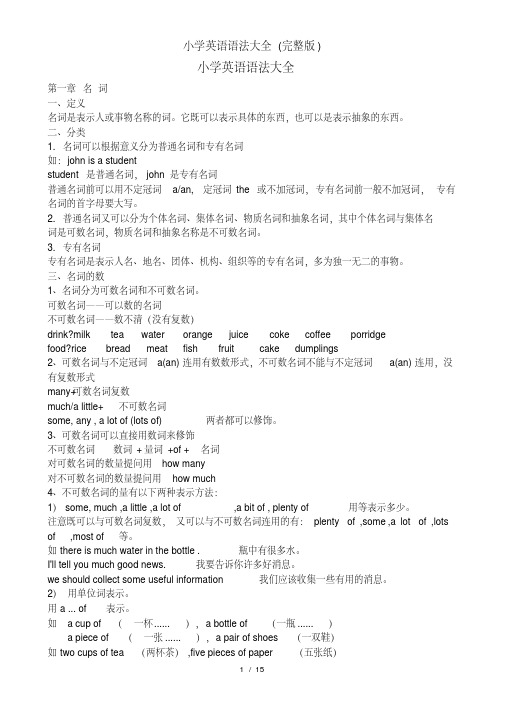
小学英语语法大全第一章名词一、定义名词是表示人或事物名称的词。
它既可以表示具体的东西,也可以是表示抽象的东西。
二、分类1. 名词可以根据意义分为普通名词和专有名词如:john is a studentstudent是普通名词,john是专有名词普通名词前可以用不定冠词a/an, 定冠词the 或不加冠词,专有名词前一般不加冠词,专有名词的首字母要大写。
2. 普通名词又可以分为个体名词、集体名词、物质名词和抽象名词,其中个体名词与集体名词是可数名词,物质名词和抽象名称是不可数名词。
3. 专有名词专有名词是表示人名、地名、团体、机构、组织等的专有名词,多为独一无二的事物。
三、名词的数1、名词分为可数名词和不可数名词。
可数名词——可以数的名词不可数名词——数不清(没有复数)drink?milk tea water orange juice coke coffee porridgefood?rice bread meat fish fruit cake dumplings2、可数名词与不定冠词a(an)连用有数数形式,不可数名词不能与不定冠词a(an)连用,没有复数形式many+可数名词复数much/a little+不可数名词some, any , a lot of (lots of) 两者都可以修饰。
3、可数名词可以直接用数词来修饰不可数名词数词 +量词 +of + 名词对可数名词的数量提问用how many对不可数名词的数量提问用 how much4、不可数名词的量有以下两种表示方法:1) some, much ,a little ,a lot of ,a bit of , plenty of 用等表示多少。
注意既可以与可数名词复数,又可以与不可数名词连用的有:plenty of ,some ,a lot of ,lots of ,most of 等。
如there is much water in the bottle .瓶中有很多水。
(完整版)小学最全英语语法汇总
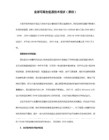
10 页 共 26 页 What (问什么事,什么物或什么工作) What are you doing? I’m reading. What is that? It’s a book. What is she?(What’s her job?) She’s a nurse. What colour(问颜色) What colour is your coat? It’s red. What time(时间) What time is it? What’s the time? It’s seven. when (什么时候) When do you get up? I get up at six thirty. When is your birthday? It’s on the 21st of December. Which(哪一个) Which is your watch, the yellow one or the white one? The yellow is mine. Who(谁) Who is the man with a big nose? He’s my uncle. Whose(谁的) Whose bag is it? Whose is this bag? It’s his bag.
2 页 共 26 页 4. 特殊的 do-does ,have-has, go-goes 2.现在进行时, (1)表示正在发生的动作,通常用“now现在, look看,linsen听”. (2)基本形式: be + 动词ing eg: I am(not) doing my homework. You/We/They are(not) reading. He/She/It is(not) eating. What are you doing? Is he reading? (3)动词的现在分词形式(动词+ing) 一般情况 +ing walk—walking 结尾是不发音的 e -e + ing come—coming 重读闭音节 双写最后一个字母+ing run-running swim-swimming 3. 一般过去时 (1) 表示过去已经发生的事情,通常用 “last …上一个…, just now刚才, a moment ago刚才,
小学英语语法大全(完整版)
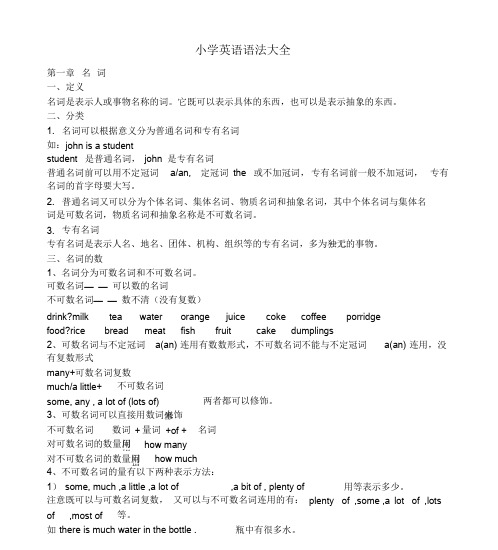
一二修问提问提小学英语语法大全第一章 名 词一、定义名词是表示人或事物名称的词。
它既可以表示具体的东西,也可以是表示抽象的东西。
二、分类1. 名词可以根据意义分为普通名词和专有名词如:john is a studentstudent 是普通名词, john 是专有名词普通名词前可以用不定冠词a/an,定冠词 the 或不加冠词, 专有名词前一般不加冠词, 专有名词的首字母要大写。
2. 普通名词又可以分为个体名词、集体名词、物质名词和抽象名词,其中个体名词与集体名词是可数名词,物质名词和抽象名称是不可数名词。
3. 专有名词专有名词是表示人名、地名、团体、机构、组织等的专有名词,多为独无的事物。
三、名词的数1、名词分为可数名词和不可数名词。
可数名词— — 可以数的名词不可数名词— — 数不清(没有复数)drink?milkfood?riceteabreadwatermeatorangefishjuicefruitcokecakecoffeedumplingsporridge2、可数名词与不定冠词a(an) 连用有数数形式,不可数名词不能与不定冠词有复数形式many+可数名词复数much/a little+不可数名词a(an) 连用,没some, any , a lot of (lots of)3、可数名词可以直接用数词来饰两者都可以修饰。
不可数名词数词 + 量词 +of + 名词对可数名词的数量用how many对不可数名词的数量用how much4、不可数名词的量有以下两种表示方法:1) some, much ,a little ,a lot of,a bit of , plenty of用等表示多少。
注意既可以与可数名词复数, 又可以与不可数名词连用的有: plenty of ,some ,a lot of ,lotsof,most of等。
如 there is much water in the bottle .瓶中有很多水。
(完整版)小学英语语法总结全集
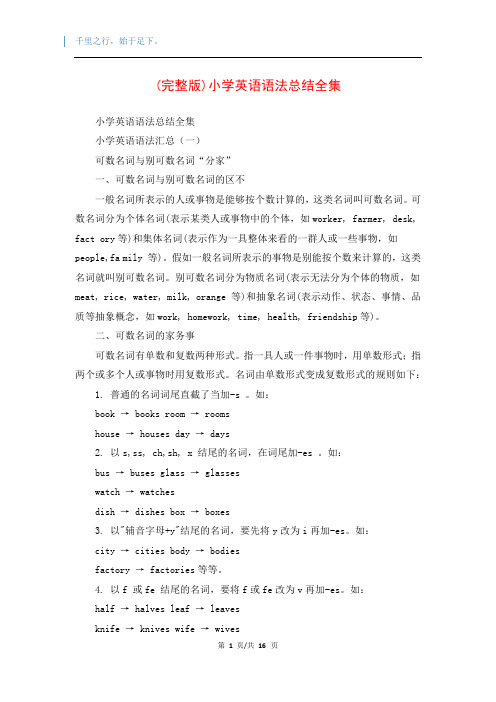
(完整版)小学英语语法总结全集小学英语语法总结全集小学英语语法汇总(一)可数名词与别可数名词“分家”一、可数名词与别可数名词的区不一般名词所表示的人或事物是能够按个数计算的,这类名词叫可数名词。
可数名词分为个体名词(表示某类人或事物中的个体,如worker, farmer, desk, fact ory等)和集体名词(表示作为一具整体来看的一群人或一些事物,如people,fa mily 等)。
假如一般名词所表示的事物是别能按个数来计算的,这类名词就叫别可数名词。
别可数名词分为物质名词(表示无法分为个体的物质,如meat, rice, water, milk, orange 等)和抽象名词(表示动作、状态、事情、品质等抽象概念,如work, homework, time, health, friendship等)。
二、可数名词的家务事可数名词有单数和复数两种形式。
指一具人或一件事物时,用单数形式;指两个或多个人或事物时用复数形式。
名词由单数形式变成复数形式的规则如下: 1. 普通的名词词尾直截了当加-s 。
如:book → books room → roomshouse → houses day → days2. 以s,ss, ch,sh, x 结尾的名词,在词尾加-es 。
如:bus → buses glass → glasseswatch → watchesdish → dishes box → boxes3. 以"辅音字母+y"结尾的名词,要先将y改为i再加-es。
如:city → cities body → bodiesfactory → factories等等。
4. 以f 或fe 结尾的名词,要将f或fe改为v再加-es。
如:half → halves leaf → leavesknife → knives wife → wives5. 特例[悄悄话:特例常常考,要记住。
小学英语语法总复习要点汇总
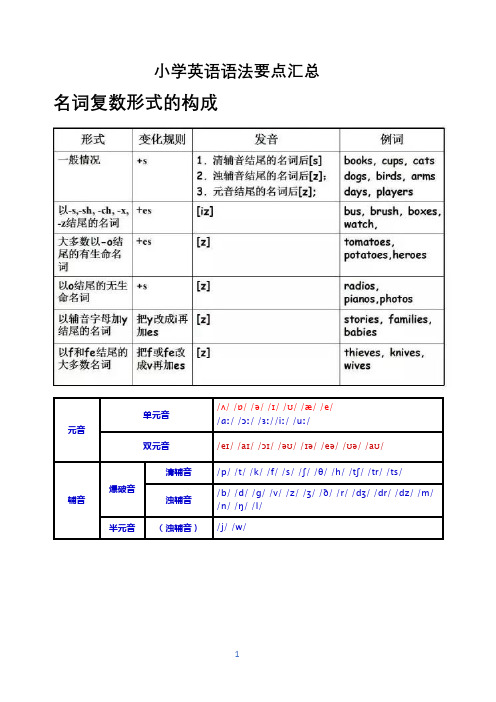
小学英语语法要点汇总名词复数形式的构成
冠词的用法
动词
动词的基本形式
第三人称单数变化规则
动词现在分词变化规则
动词过去式的变化规则
重读闭音节:以一个或几个辅音字母结尾、中间只有一个元音,该元音不发字母音,而发短元音,且该音节重读的
不规则动词见附表1
序数词
形容词比较级和最高级规则
不规则变化见附表二
附表1 - 不规则动词AAA型
AAB型
ABA型
ABB型
ABC型
两种变化形式
附表2 比较级和最高级的不规则形式1)少数单音节词前面加 more-, most- 构成比较级和最高级
2)不规则变化
3)下列形容词和副词的比较级和最高级有两种形式
4) 下列形容词和副词没有比较级和最高级(即表示”最高程度”或”绝对状态”的形容词和副词没有比较级和最高级)
empty , wrong , perfect , unique , extreme , excellent , favourite , true , right , correct , extremely ...
附表3 元音、辅音。
小学PEP英语总复习3-6年级英语语法总结(最全)
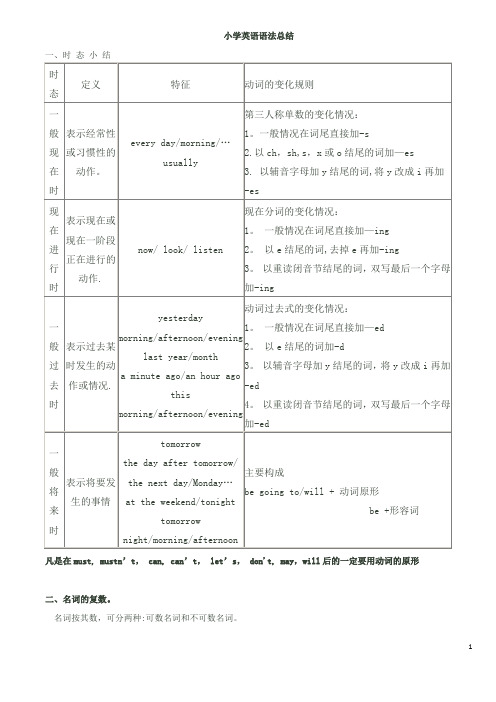
小学英语语法总结一、时态小结凡是在must, mustn’t,can, can’t,let’s, don't, may,will后的一定要用动词的原形二、名词的复数。
名词按其数,可分两种:可数名词和不可数名词。
可数名词的复数变化规则:1。
一般情况下,直接在词尾加-s,如:girl—girls, book-books, pen-pens2。
以s,x,sh,ch结尾的词,在词后加-es, 如:class—classes, box—boxes, match—matches,3. 以辅音字母+y结尾的,变y 为i 再加-es,如:city—cities, family—families, country— countries 4。
以f或fe结尾的,变f或fe为v再加-es,如:knife—knives, wife—wives, life—lives,5。
以o 结尾的加—es或—s, 如: radio-radios, tomato—tomatoes, potato—potatoes, zoo—zoos,photo-photos,6。
man—men, woman-women, foot—feet, child-children,三、形容词的比较级、最高级。
形容词有比较级与最高级之分,单音节词的变化规则:1。
一般情况下,直接在词尾加-er或—est, 如:small-smaller—smallest, short—shorter—shortest2. 以e结尾的,加-er或-est,如:large—larger—largest, nice—nicer—nicest。
3.以辅音字母+y结尾的,变y 为i 再加—er或-est, 如:busy—busier—busiest, heavy—heavier-heaviest。
4。
以重读闭音节,一个辅音字母结尾的,双写该字母,再加—er或—est,如:big—bigger—biggest,thin-thinner-thinnest。
小学语法总结全集英语(7篇)

1:“first”是序数词,与“the”相连,解释为第一。
2:像“first,term,world”作为词组出现时前面要加“the”。
3:“all”所有;后面的可数名词用复数形式,be动词用“are”。
4:“any”一些;用在否定句和一般疑问句中,与“some”同义。
“some”用在肯定句中。
5:there be+数词,采用“就近原则”。
6:a map of China 与 a map of the world 要牢记。
7:要用“on the wall”,不能用“in the wall”。
门、窗在墙上才能用“in the wall”。
8:can 后+动词原形。
9:play+the+乐器; play+球类;10:like的用法11:动词变动名词形式方法:A--直接在动词后面+ing形式(大多数)。
B--以不发音的“e”结尾的,要去掉e后再+ing,比如:dancing,making,riding。
C--重读be音节,末尾只有一个辅音,须双写末尾的字母后再+ing,如:running,swimmi ng,sitting,putting。
12:现在进行时的构成:be动词+动词ing形式。
标志:now、look、listen、its time to。
13:现在进行时的一般疑问句 /问--be动词+人称+时态(动词ing)答--Yes,he/She/it is/am/are. No,he/She/it isnt/arent/am not.14:用Are you...? Yes,I am/ we are. No,Im not/We arent.15: 动词后+人称宾格形式.16:一般现在时的构成:第三人称单数(三单)。
要注意:后面的动词+s或es。
特例:have→has do→dose go→goes; 标志:often,usually。
17:有些名词变动词时要变形式,例如:teacher→teach;driver→drive.1.一般现在时一般现在时态中,动词一般用原形。
(完整版)三至六年级英语语法知识汇总

三至六年级英语语法知识汇总一、词类:1、动词:行为动词、be动词、情态动词。
(1)行为动词原形、+s/es、+ed、+ing,具体判断方法如下:(2)be动词a、Am--was Is --was Are--were 口诀:我用am, 你用are, is用在他她它,所有复数全用are。
b、肯定和否定句I am (not) from London. He /She is(not) a teacher. My hair is(not) long. Her eyes are(not) small.c、一般疑问句Am I …? Yes, you are. No, you aren’t. Are you/they…? Yes,we/ they are. No,we/ they aren’t. Is the cat fat? Yes, it is. No, it isn’t.is、am、are为一类,一般用于一般现在时、现在进行时和一般将来时中。
was和were为另一类,一般用于一般过去时。
(3)情态动词can、must、should、would、may。
情态动词后动词总是用原形。
(不受其他任何条件影响)2、名词这里强调两点:不可数名词都默认为单数,所以总是用is或者was。
如何加后缀:a.一般情况下,直接加-s,如:book-books, bag-bags, cat-cats, bed-bedsb.以s. x. sh. ch结尾,加-es,如:bus-buses, box-boxes, brush-brushes, watch-watchesc.以“辅音字母+y”结尾,变y为i, 再加-es,如:family-families, strawberry-strawberriesd.以“f或fe”结尾,变f或fe为v, 再加-es,如:knife-knivese.不规则名词复数: man-men, woman-women, policeman-policemen, policewoman-policewomen, mouse-mice child-children foot-feet ,.tooth-teeth fish-fish, people-people, Chinese-Chinese, Japanese-Japanese3、形容词(包括副词)形容词表示某一事物或的特征,副词表示某一动作的特征。
小学英语语法大全(完整版)
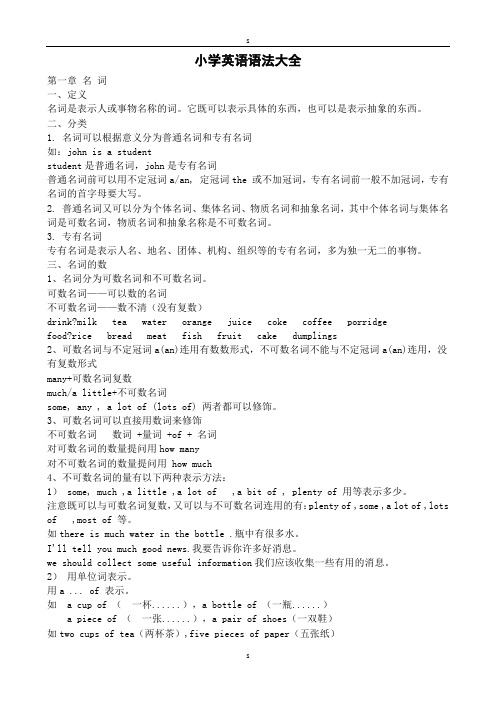
小学英语语法大全第一章名词一、定义名词是表示人或事物名称的词。
它既可以表示具体的东西,也可以是表示抽象的东西。
二、分类1. 名词可以根据意义分为普通名词和专有名词如:john is a studentstudent是普通名词,john是专有名词普通名词前可以用不定冠词a/an, 定冠词the 或不加冠词,专有名词前一般不加冠词,专有名词的首字母要大写。
2. 普通名词又可以分为个体名词、集体名词、物质名词和抽象名词,其中个体名词与集体名词是可数名词,物质名词和抽象名称是不可数名词。
3. 专有名词专有名词是表示人名、地名、团体、机构、组织等的专有名词,多为独一无二的事物。
三、名词的数1、名词分为可数名词和不可数名词。
可数名词——可以数的名词不可数名词——数不清(没有复数)drink?milk tea water orange juice coke coffee porridgefood?rice bread meat fish fruit cake dumplings2、可数名词与不定冠词a(an)连用有数数形式,不可数名词不能与不定冠词a(an)连用,没有复数形式many+可数名词复数much/a little+不可数名词some, any , a lot of (lots of) 两者都可以修饰。
3、可数名词可以直接用数词来修饰不可数名词数词 +量词 +of + 名词对可数名词的数量提问用how many对不可数名词的数量提问用 how much4、不可数名词的量有以下两种表示方法:1) some, much ,a little ,a lot of ,a bit of , plenty of 用等表示多少。
注意既可以与可数名词复数,又可以与不可数名词连用的有:plenty of ,some ,a lot of ,lots of ,most of 等。
如there is much water in the bottle .瓶中有很多水。
- 1、下载文档前请自行甄别文档内容的完整性,平台不提供额外的编辑、内容补充、找答案等附加服务。
- 2、"仅部分预览"的文档,不可在线预览部分如存在完整性等问题,可反馈申请退款(可完整预览的文档不适用该条件!)。
- 3、如文档侵犯您的权益,请联系客服反馈,我们会尽快为您处理(人工客服工作时间:9:00-18:30)。
❖现在进行时专项练习: 一、写出下列动词的现在分词: run_______ swim _______make______ begin_____ go________ like________ write______ shop ______have ______ sing ______dance ______put________ see_______ love_______ live_______ take_______come _____ get _______ stop_______ sit ________
一般将来时
一、概念:表示将要发生的动作或存在的状 态及 打算、计划或预备做某事。句中一般 有以下时间状语:tomorrow, next day (we ek, month, year…),soon, the day after to morrow(后天)等。
二、基本结构:①be going to do; ②will do.
1、问人。Who 例如:I’m going to New York soon. → Who’s going to New York soon.
2、问干什么。What … do.例如: My father is going to watch a race with me this afternoon. →What is
小学英语语法总复习
名词复数规则
1.一般情况下,直接加-s,如:book-books, bag-bags, cat-cats, bed-beds
2.以s. x. sh. ch结尾,加-es, 如:bus-buses, box-boxes,
brush-brushes, watch-watches
3.以“辅音字母 y”结尾,变y为i, 再加-es, 如:family-families, strawberry-strawberries
当主语为第三人称单数,要用does构成一般疑 问句
如 -Does she go to work by bike? - Yes, she does. / No, she doesn't.
动词 s的变化规则 1.一般情况下,直接加-s,
如:cook-cooks, milk-milks
2.以s. x. sh. ch. o结尾,加-es, 如:guess-guesses, wash-washes, watch-watches, go-goes
strawberry _____
thief _____
you _____ peach___ sandwich ___
man_____ woman___
一般现在时
一般现在时基本用法介绍 一般现在时的功能 1.表示事物或人物的特征、状态。
如:The sky is blue.天空是蓝色的。 2.表示经常性或习惯性的动作。
your father going to do with you this afternoon.
3、问什么时候。When.例如:She’s going to go to be d at nine. →When is she going to bed?
六、同义句:be going to = will I am going to go swimming tomorrow(明天).
现在进行时
1、现在进行时表示现在正在进行或发生的动作, 也可表示当前一段时间内的活动或现阶段正在进行 的动作。 2、现在进行时的肯定句基本结构为be 动词ing.
3、现在进行时的否定句在be后加not。
4、现在进行时的一般疑问句把be动词调到句首。
5、现在进行时的特殊疑问的基本结构为: 疑问词+be动词+主语+doing+其它? 但疑问词当主语时其结构为: 疑问词+be动词+doing+其它?
如: I don't like bread. 当主语为第三人称单数,用doesn‘t构成否定句
如:He doesn't often play.
一般疑问句:Do( Does ) 主语 动词原形 其它。 如- Do you often play football? - Yes, I do. / No, I don't.
如:I get up at six every day.我天天六点 起床。
3.表示客观现实。 如:The earth goes around the sun.地 球绕着太阳转。
一般现在时的构成 1. be动词:主语 be (am, is, are) 其它。 如:
I am a boy.我是一个男孩。
2.行为动词:主语 行为动词( 其它)。如: We study English.我们学习英语。 当主语为第三人称单数(he, she, it)时,
要在动词 后加“-s”或“-es” 如:Mary likes Chinese.玛丽喜欢汉语。
一般现在时的变化 1. be动词的变化。 否定句:主语 be not 其它。
4.以“f或fe”结尾,变f或fe为v, 再加-es, 如:knife-knives leaf——leaves
5.不规则名词复数: man-men, woman-women, child-children;foot-feet;tooth-teeth
fish-fish, people-people, sheep-sheep Chinese-Chinese, Japanese-Japanese
❖写出下列各词的复数 I _____ him ____
this _______
❖her___ diary ___ day______
❖foot_____ book_____ dress ____
tooth____ sheep ____ box_____
_________________ 3. He likes play games after class.
_________________ 4. Mr. Wu teachs us English.
__________________ 5. She don’t do her homework on Sund ays. _______________
动词加ing的变化规则 1.一般情况下,直接加ing,
如:cook-cooking
2.以不发音的e结尾,去e加ing, 如:make-making, taste-tasting
3.假如末尾是一个元音字母和一个辅音字 母,双写末尾的辅音字母,再加ing 如:run-running, stop-stopping
3.以“辅音字母 y”结尾,变y为i, 再加-es, 如study-studies
一、 写出下列动词的第三人称单数 drink ______ go _______ stay ____
make ______look ______ have_______ pass_____ carry ____ 二、用括号内动词的适当形式填空。 1. He often ________(have) dinner at ho me. 2. Daniel and Tommy _______(be) in
句型转换: 1. They are doing housework .(分别改成一
般疑问句和否定句) _________________________________ _________________________________
2.The students are cleaning the classroo m . ( 改一般疑问句并作肯定和否定回答) _________________________________ _________________________________
Monday? I ___ ___ ___ play basketball.
3. 你妈妈这个周末去购物吗?是,她要去买 一些水果。 ___ your mother ____ ___ go shopping this _____? Yes, she _____. She ____ ____ ____ buy some fruit.
= I will go swimming tomorrow.
练习:填空。 1. 我打算明天和朋友去野炊。 I____ _____ _____ have a picnic with my
friends. I ______ have a picnic with my friends.
2. 下个星期一你打算去干嘛? 我想去打篮 What ____ _____ _____ _____ _____next
7. The girl _______(teach) us English on Sundays.
8. She and I ________(take) a walk together every evening.
三、按照要求改写句子 1. Daniel watches TV every evening.(改为否 定句) ______________________________________
4. We go to school every morning.(改为否定 句) ______________________________________
改错(划出错误的地方,将正确的写在横线上) 1. Is your brother speak English?
__________________ 2. Does he likes going fishing?
一般将来时 否定句:在be动词(am, is, are)l后加not 或情态动词will后加not成won’t。 例如:I’m going to have a picnic this afte rnoon.→ I’m not going to have a picnic t his afternoon.
